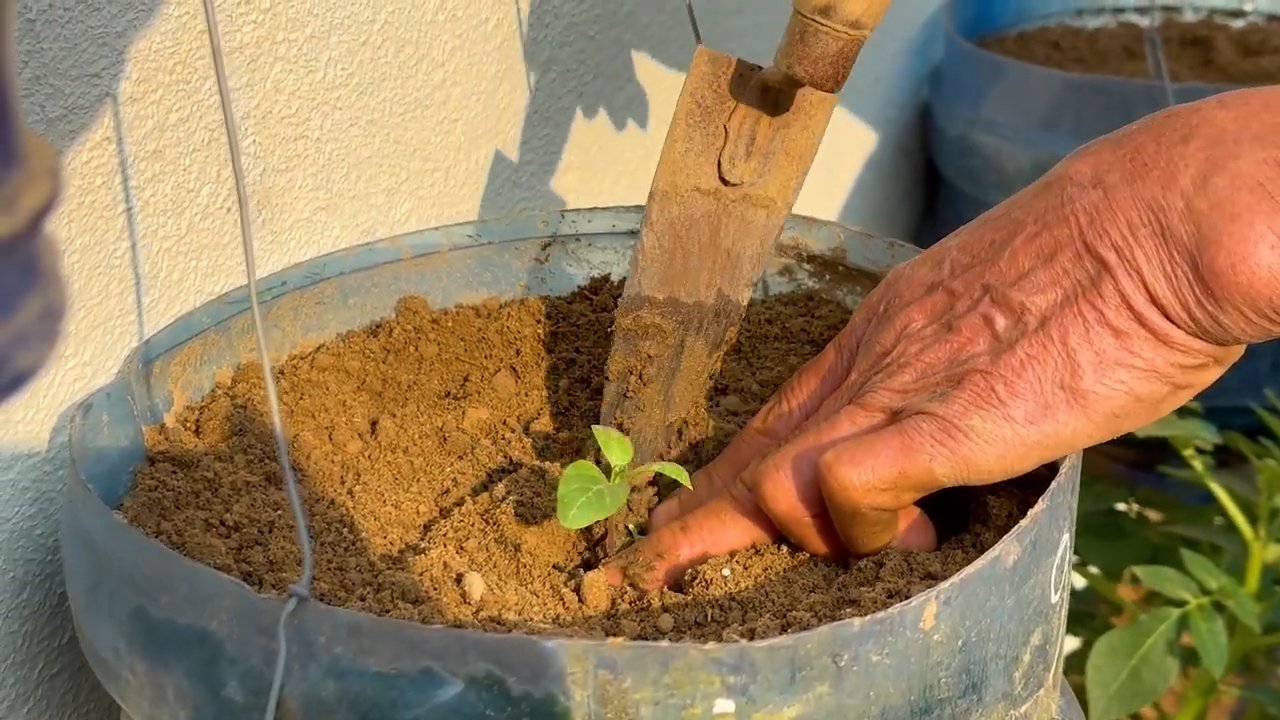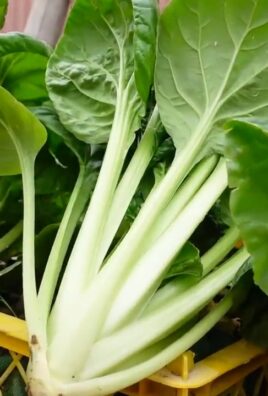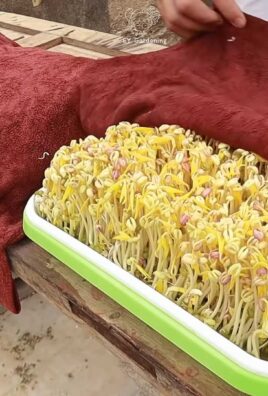Growing White Eggplants might sound like an exotic culinary adventure reserved for seasoned gardeners, but trust me, it’s a surprisingly achievable and rewarding project for anyone, even if you’re just starting out! Have you ever dreamed of strolling through your own backyard, plucking a creamy white eggplant fresh from the vine, ready to be transformed into a delicious dish? This isn’t just a fantasy; it’s a reality you can create with a few simple tricks and a little bit of DIY spirit.
Eggplants, in general, have a rich history, originating in Asia and gradually making their way across the globe. While the familiar purple variety is a staple in many cuisines, the white eggplant offers a unique visual appeal and a slightly milder, sweeter flavor. They’re not just a novelty; they’re a conversation starter and a beautiful addition to any garden.
So, why should you embark on this growing white eggplants journey? Well, beyond the sheer satisfaction of nurturing something from seed to harvest, growing your own food gives you control over what you eat. You can avoid harmful pesticides and enjoy the freshest, most flavorful produce imaginable. Plus, let’s be honest, there’s something incredibly therapeutic about getting your hands dirty and connecting with nature. In this article, I’m going to share some easy-to-follow DIY tricks and hacks that will help you successfully cultivate these beautiful and delicious white eggplants, even if you think you have a “brown thumb.” Get ready to impress your friends and family with your homegrown culinary creations!

Growing White Eggplants Yourself: A Comprehensive DIY Guide
Hello dear garden friends! Do you feel like growing something special in your garden? Then let’s grow white eggplants together! They are not only a visual highlight but also a great taste variation. I will show you how you can easily do this yourself.
Why white eggplants?
White eggplants are not only beautiful to look at but also have some advantages over their purple relatives:
- Milder taste: Many find that white eggplants taste less bitter.
- More tender skin: The skin is often thinner and does not necessarily need to be peeled.
- Decorative: They are simply an eye-catcher in the garden and on the plate!
What you need for cultivation
Before we get started, here is a list of everything you need:
- Eggplant seeds (white variety): Look for a high-quality variety that is suitable for your climate.
- Seed starting mix: Special soil for starting young plants.
- Seed starting pots or trays: Small containers for sowing.
- Larger pots or a garden bed: For the later plants.
- Vegetable soil: Nutrient-rich soil for the growth of the eggplants.
- Plant stakes: to support the plants.
- Watering can or garden hose: For watering.
- Fertilizer: Special vegetable fertilizer or compost.
- Patience: Eggplants need some time to grow!
Sowing and Starting Seeds
Starting the seeds is the first important step. Here I will show you how to do it best:
- Prepare for sowing: Fill your seed starting pots or trays with seed starting mix. Lightly press the soil down.
- Sow the seeds: Place the eggplant seeds about 0.5 cm (0.2 inches) deep in the soil. 2-3 seeds per pot or tray are sufficient.
- Cover and water: Lightly cover the seeds with soil and water them gently. The soil should be moist, but not wet.
- Keep them warm: Eggplants need warmth to germinate. Place the pots in a bright and warm place (approx. 22-25°C / 72-77°F). A mini-greenhouse or a windowsill above a heater is ideal.
- Maintain moisture: Keep the soil evenly moist. You can cover the pots with plastic wrap to increase the humidity. But be sure to air out the plastic regularly to prevent mold.
- Wait for germination: After about 1-2 weeks, the first seedlings should be visible.
- Pricking out: As soon as the seedlings have their first true leaves (after the cotyledons), you can prick them out. This means that you transplant the strongest plants into larger pots. Be careful not to damage the roots.
Planting Outdoors or in Pots
After the young plants are strong enough, they can be moved outdoors or into larger pots.
- Hardening off: Before you plant the eggplants outdoors, you should harden them off. This means that you slowly acclimate them to the outdoor conditions. Place them outside for a few hours during the day and bring them back in at night. Increase the time outdoors every day.
- Choose a location: Eggplants love the sun! Choose a sunny and sheltered spot.
- Prepare the soil: Loosen the soil well and mix in compost or vegetable fertilizer.
- Planting: Plant the eggplant plants with sufficient spacing (approx. 40-50 cm / 16-20 inches) in the soil.
- Watering: Water the plants well after planting.
- Install plant stakes: Eggplant plants can get quite large and need support. Install plant stakes to which you can tie the plants.
Care of the Eggplant Plants
Proper care is crucial for a rich harvest.
- Watering: Eggplants need regular water, especially during flowering and fruiting. It’s best to water in the morning so that the leaves can dry off and fungal diseases are avoided.
- Fertilizing: Fertilize the eggplant plants regularly with vegetable fertilizer or compost. Pay attention to the dosage instructions on the packaging.
- Pruning: Regularly remove side shoots that grow between the main stem and the leaves. This promotes fruit formation.
- Pests and diseases: Watch out for pests such as aphids or potato beetles. If necessary, you can use biological pesticides. Fungal diseases can also occur. Ensure good ventilation and avoid waterlogging.
- Pollination: Eggplants are self-pollinating, but you can support pollination by gently shaking the flowers.
Harvest Time
The harvest time for white eggplants is usually in late summer or autumn.
- Recognizing ripeness: The eggplants are ripe when they have reached their full size and the skin is shiny. Press lightly on the fruit. It should give slightly.
- Harvesting: Cut the eggplants with a sharp knife or garden shears. Leave a small stem on the fruit.
- Storage: Eggplants do not keep for long. Store them in the refrigerator and use them within a few days.
Additional Tips for Successful Cultivation
- Variety selection: Inform yourself about different varieties of white eggplants and choose a variety that is suitable for your climate. For example, there are varieties like ‘Bianca’, ‘Casper’ or ‘Dourga’.
- Starting seeds: Start the seeds early (February/March) to give the eggplants a head start.
- Mulching: Mulch the soil around the eggplant plants with straw or grass clippings. This keeps the soil moist and suppresses weeds.
- Greenhouse: If you don’t have a sunny location, you can also grow the eggplants in a greenhouse.
- Companion planting: Eggplants get along well with basil, marigolds or lettuce.
Common Problems and Solutions
- Yellow leaves: Can indicate a nutrient deficiency or waterlogging. Fertilize the plants and ensure good drainage.
- Aphids: Combat aphids with a water-dish soap mixture or with beneficial insects such as ladybugs.
- Fungal diseases: Ensure good ventilation and avoid waterlogging. If necessary, you can use a fungicide.
- No fruit: Can be due to a lack of pollination or too little sun. Gently shake the flowers and make sure the plants get enough sun.
Recipes with White Eggplants
White eggplants are versatile. Here are a few ideas:
Eggplant curry: Use the eggplants in a delicious curry.
Grilled eggplants: Cut the eggplants into slices, brush them with olive oil, and grill them.

Conclusion
So, there you have it! Growing white eggplants isn’t just about adding a unique vegetable to your garden; it’s about embracing a rewarding and surprisingly simple DIY project that yields delicious and visually stunning results. We’ve walked you through the process, from selecting the right seeds to nurturing your plants and harvesting your creamy white treasures.
Why is this a must-try? Because it’s more than just gardening; it’s an experience. Imagine the satisfaction of serving a dish featuring eggplants you’ve grown yourself, their ivory hue a conversation starter and a testament to your green thumb. Beyond the aesthetic appeal, white eggplants offer a milder, less bitter flavor than their purple counterparts, making them incredibly versatile in the kitchen. They’re fantastic grilled, roasted, stuffed, or even pickled!
But the benefits extend beyond the plate. Gardening, in general, is a fantastic stress reliever, a way to connect with nature, and a source of immense personal satisfaction. Growing white eggplants adds an extra layer of intrigue and accomplishment to this already rewarding activity.
Ready to take your gardening to the next level?
Don’t be afraid to experiment! Try different varieties of white eggplants, such as ‘Casper’ or ‘White Beauty,’ to discover your favorite. Consider companion planting with herbs like basil or thyme to deter pests and enhance the flavor of your eggplants. You can even try growing them in containers if you have limited garden space.
And remember, gardening is a journey, not a destination. There will be challenges along the way, but the rewards are well worth the effort. Don’t be discouraged by setbacks; learn from them and keep growing!
We’re confident that you’ll find growing white eggplants to be a delightful and enriching experience. So, grab your seeds, get your hands dirty, and prepare to be amazed by the beauty and flavor of these unique vegetables.
We encourage you to share your experiences with us! Post photos of your white eggplant harvest on social media using #WhiteEggplantDIY and tell us about your favorite ways to prepare them. We can’t wait to see what you create! Your insights and tips will help other gardeners embark on their own white eggplant adventures. Let’s build a community of white eggplant enthusiasts!
Frequently Asked Questions (FAQ)
What are the benefits of growing white eggplants compared to purple eggplants?
White eggplants generally have a milder, less bitter flavor than purple eggplants. This makes them more versatile in cooking, as they can be used in a wider range of dishes without overpowering other flavors. Some people also find the texture of white eggplants to be creamier and more delicate. Additionally, their unique color adds visual appeal to your garden and your meals. They are also reported to have thinner skin than their purple counterparts.
Are white eggplants more difficult to grow than purple eggplants?
No, white eggplants are not inherently more difficult to grow than purple eggplants. The growing requirements are essentially the same. They need plenty of sunlight (at least 6-8 hours per day), well-drained soil, and consistent watering. The key is to provide them with the right conditions and protect them from pests and diseases. Starting with healthy seedlings or seeds and following proper gardening practices will ensure a successful harvest.
What kind of soil is best for growing white eggplants?
White eggplants thrive in well-drained, fertile soil that is rich in organic matter. The ideal soil pH is between 6.0 and 6.8. Before planting, amend the soil with compost or well-rotted manure to improve its structure and nutrient content. This will help the plants establish strong roots and produce abundant fruit. Avoid heavy clay soils, as they can retain too much moisture and lead to root rot. If you have clay soil, consider growing your eggplants in raised beds or containers.
How often should I water my white eggplant plants?
Water your white eggplant plants regularly, especially during hot, dry weather. Aim to keep the soil consistently moist but not waterlogged. Water deeply at the base of the plants, avoiding wetting the foliage, which can increase the risk of fungal diseases. A good rule of thumb is to water when the top inch of soil feels dry to the touch. Mulching around the plants can help retain moisture and suppress weeds.
What are some common pests and diseases that affect white eggplants, and how can I prevent them?
Common pests that affect white eggplants include aphids, flea beetles, and tomato hornworms. To prevent pest infestations, inspect your plants regularly and remove any pests you find by hand. You can also use insecticidal soap or neem oil to control pests. Common diseases include fungal diseases like early blight and verticillium wilt. To prevent diseases, ensure good air circulation around your plants, avoid overhead watering, and practice crop rotation. Using disease-resistant varieties can also help.
When is the best time to harvest white eggplants?
Harvest white eggplants when they are firm, glossy, and have reached their mature size, typically around 6-8 inches long. The skin should be smooth and unblemished. Gently press the skin; if it gives slightly, the eggplant is ripe. Use a sharp knife or pruning shears to cut the eggplant from the plant, leaving a short stem attached. Harvesting regularly will encourage the plant to produce more fruit. Overripe eggplants can become bitter and seedy.
Can I grow white eggplants in containers?
Yes, white eggplants can be successfully grown in containers, making them a great option for gardeners with limited space. Choose a large container, at least 12-14 inches in diameter, with good drainage holes. Use a high-quality potting mix and provide the plants with plenty of sunlight and water. Container-grown eggplants may need to be fertilized more frequently than those grown in the ground.
How can I use white eggplants in cooking?
White eggplants can be used in a variety of dishes, just like purple eggplants. Their milder flavor makes them a great addition to stir-fries, curries, and Mediterranean dishes. They can be grilled, roasted, stuffed, or even pickled. Try using them in eggplant parmesan, baba ghanoush, or ratatouille. Their creamy texture also makes them a delicious addition to soups and stews. Don’t forget to experiment and discover your own favorite ways to prepare them!
Are there different varieties of white eggplants?
Yes, there are several varieties of white eggplants available, each with its own unique characteristics. Some popular varieties include ‘Casper,’ known for its pure white skin and mild flavor; ‘White Beauty,’ which produces large, oval-shaped fruits; and ‘Listada de Gandia,’ a beautiful heirloom variety with white and purple stripes. Experiment with different varieties to find the one that best suits your taste and growing conditions.
How do I store white eggplants after harvesting?
Store white eggplants in the refrigerator, unwashed, in a plastic bag or container. They will typically last for about a week. Avoid storing them near ethylene-producing fruits like apples and bananas, as this can cause them to ripen and spoil more quickly. Before using, wash the eggplants thoroughly and trim off the stem end.




Leave a Comment